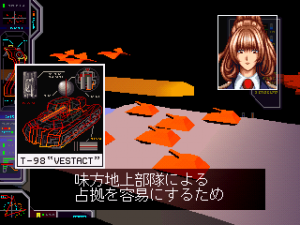Airgrave (エアグレイブ)
Developer: Santos
Release Date: 1996
Platforms: PlayStation
As the follow-up to Santos’ previous PS1 shoot-em-up, Stahlfeder: Tekkou Hikuudan, Airgrave is an improvement in every way. It features proper in-game storytelling from the perspective of four playable characters, more detailed environments, and gameplay that’s mechanically denser and more challenging while still remaining approachable. These improvements are backed with an appropriate level of confidence, something that’s evident in the way the game stylishly introduces all of its 3D bosses by zooming in on them from all angles while detailing their specs and abilities. The music this time around was done by Shigenori Masuko of Studio Cliché, a team founded by Fumito Tamayama, who composed for games like Decap Attack, Linkle Liver Story, and Mega Drive cult darling Battle Mania: Daiginjou.
The story takes place across eight stages as the four protagonists (with the help of a supporting cast) launch an offensive against the MUCOC forces. Mission briefings take place in between every stage, but you also get different fully voiced cutscenes depending on who you’re playing as. Each character’s ship has different stats and their stories feature unique 2D animations, cockpit designs, and endings, providing a lot of flavor and incentive for multiple playthroughs. If you can’t understand what’s happening or don’t want any story, the game provides an option to turn off most of the cutscenes as well.
While the gameplay here isn’t much different compared to Stahlfeder, Airgrave goes back to the genre fundamentals established by Xevious through an increased emphasis on grounded enemies. As you shoot, you’ll automatically launch bombs meant for grounded targets, but if you hold the shot button, you can pull up a targeting cursor andlock-on to multiple enemies simultaneously. The lock-on often feels too slow to keep up with the speed of the action, but if you can get the hang of it, you’ll earn bonus points for eliminating specific grounded targets in each stage. As you defeat enemies, you also build up meter for an Overdrive mode, which lets you shoot more bullets and lock-on to grounded targets instantaneously. It’s a useful panic button, but one that doesn’t remove all of the challenge since you’re not invincible during it.
In the face of all the competition on the PS1, Airgrave doesn’t stand as one of the platform’s best shoot-em-ups and part of its appeal will be lost on anyone who can’t understand all the dialogue, but it’s a solid effort all the same and certainly worth at least one playthrough.




























